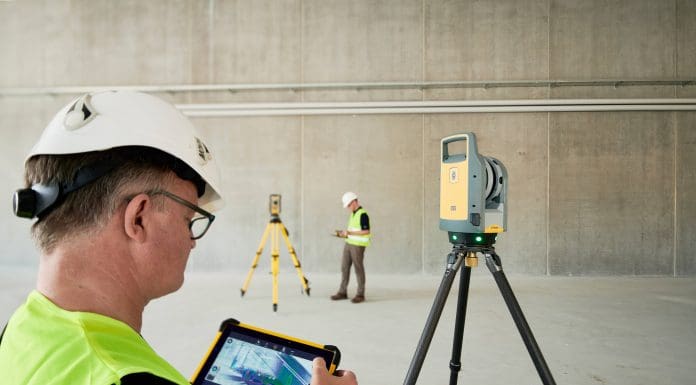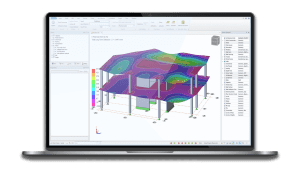
If we are to truly deliver sustainably, faster and safer then connected workflows are a must. David Sanderson, analysis and design product manager at Trimble, explores the value of connected ecosystems and workflows, and what this can look like on the ground for construction teams
At the heart of an efficient, productive and coordinated construction workflow is a streamlined flow of data, stretching from Preparation & Briefing (RIBA Stage 1) to Handover & Use (RIBA Stages 6 and 7).
Connected data connects teams, disciplines, software and construction stages, taking you from the initial concept design to structural analysis, detailing and beyond.
It also connects places, providing a bidirectional link between the office and the field. With the connection between digital hardware and software, you can import real-world survey data into the 3D modelling environment, and then push this back out to the field for reliable setting out.
Even once construction is underway, data connectivity ensures that all site progress, concrete pours and processes are tracked and reported for easy traceability and management back in the office.
Disrupting this flow of data can lead to the loss of information, corruption of data, wasted time and data silos – to name just a few. It can also lead to increased Requests for Information (RFIs), when the goal is to reduce them. Not only can RFIs extend the duration of a project, they can also be costly.
Interoperability
To avoid this, it’s important to focus on interoperability and look for software providers that invest in an open BIM approach.
Consider, for example, the Concept Design stage, when the architect is liaising with the early stage structural engineers. Generally speaking, the concrete scheme will have been modelled by the architect (often in AutoDesk Revit, or similar) and it is then the structural engineer’s responsibility to review this within a design and analysis software package.
Here, the engineer will apply loads and critical data, carry out a structural analysis of the proposed concrete design, make any updates or suggestions, and send the revised model back to the architect for further review.
With direct integration and communication between the architectural modelling software and the structural analysis software, the 3D BIM models can easily be shared from one to the other and vice versa, as many times as is needed, all while maintaining the data and integrity of the model itself.
In comparison, consider how this process would look without this direct link – an obstacle that many architects and engineers are faced with every day.
Rather than being able to benefit from the automated capabilities and instantly import the model and its data into your chosen software package, the structural engineer would instead have to make all changes manually, cross-referencing the electronic drawings received from the architect and marking those up in their own structural design model. Such a manual process understandably leaves it wide open to human error, in turn potentially leading to major issues and project delays.

Connected workflows reduce inefficiencies across the entire project lifecycle
It’s a similar situation when you consider the coordination between the Spatial Coordination (Stage 3) and Technical Design (Stage 4) phases, with communication required between the structural engineer and the detailer in the drawing office. These are two significant stages of a project and cannot be considered in isolation; you cannot have the constructible model without the engineered design model.
Given the time and resources spent by structural engineers in developing the completed engineered model, why should this time then be put to waste by an inefficient transfer of information, with teams essentially having to build the model twice?
Without full software coordination and integration, project teams can be faced with having to manually migrate the data across from one model and one software to another. As well as being a clearly inefficient use of time, essentially doing the same job twice, this can also result in the loss of information or corruption of data, with a project able to easily fall foul of data silos.
Data liberation
It’s all about making the construction data readily available to those who need it, achieved through the use of cloud sharing platforms, APIs and an open BIM approach.
At the heart of this data liberation is design intent. Take rebar, for example, a notoriously complex feature of reinforced content. With connected workflows, engineers can effectively communicate the design intent, pushing this information through to the 3D model for detailing. There the detailing team can visualise everything clearly, allowing for rebar congestion or problem areas to be easily flagged, reducing the likelihood of rework or errors on site.
This same information-rich 3D data can then be pushed further through to fabrication, reusing the information to automatically generate bar bending schedules and drawings. It’s all about using and sharing a project’s constructible data and building upon it, as the project progresses from initial design through to site.
Building Safety Act
Digital, accurate and accessible data is at the heart of mastering compliance with the Building Safety Act. That said, it’s not enough to just have a common data environment. Instead, we need to be taking an open platform approach to BIM, with the need for IFC files of BIM models to remain functional and accessible, as well as seamless and broadened interoperability between software and platforms.
Some providers (like Trimble) are actively championing APIs and interoperability, recognising the need for open data workflows and connected platforms, regardless of the originating software.
If the industry is to master compliance with the Building Safety Act and its new evidential frameworks, it’s clear we need a connected and integrated ecosystem of software tools, enabling a streamlined flow of data communicated between all project stages, stakeholders and platforms – providing the Golden Thread of data needed to take you smoothly from Gateways One to Three.
Learn more about Trimble and our approach to connected construction, here: https://bit.ly/3Z6Gfv4.
Please note: This is a commercial profile
The post From concept to concrete construction: The case for connected workflows appeared first on Planning, Building & Construction Today.

